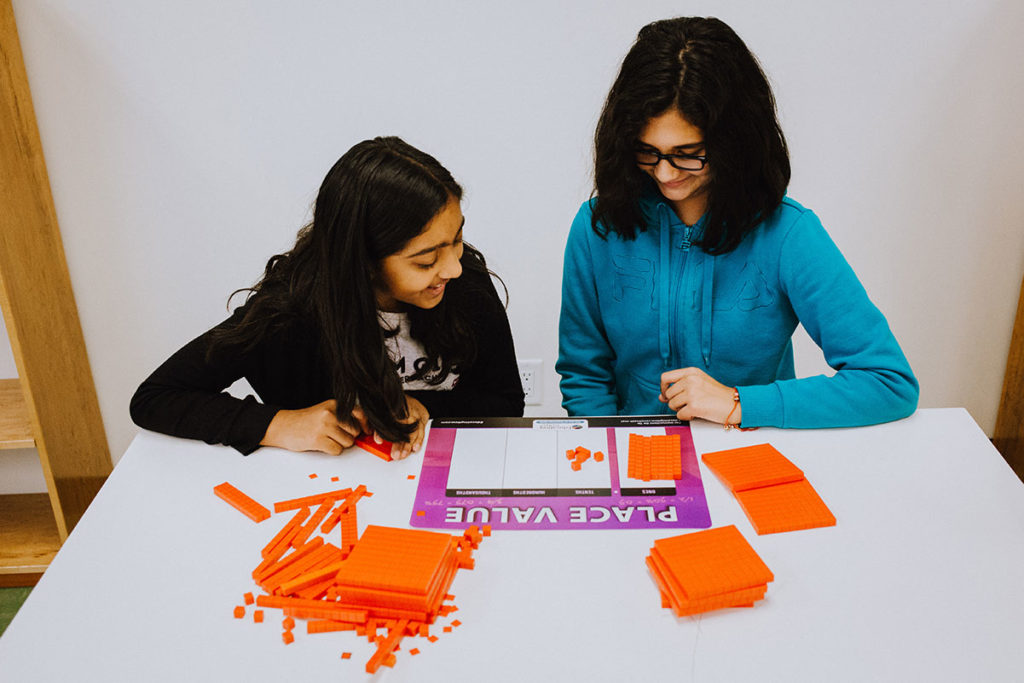Although I am a trained math teacher, the majority of the work I currently do is creating and facilitating professional development sessions in math education for K-12 educators. In this blog post I will share how I integrate ethnomathematics into this work as a way to make mathematics more accessible, engaging, and relevant for students. I’m fortunate to work with many different educators in many different environments, which allows me to learn alongside my colleagues and to explore many facets of math education. I integrate ethnomathematics in many ways (depending on the professional development session); the most common are: using manipulatives and visuals regularly in the math classroom, incorporating place-based and land-based activities, and utilizing collaborative learning groups in math class.
Using manipulatives, images, and other hands-on approaches are important components of ethnomathematics. When students are able to make sense of the problems or concepts they are learning by using these visuals to literally see the mathematics, it opens up so many doors. Visually understanding mathematics can be a completely different experience than being able to memorize a procedure and for many educators this creates some initial discomfort usually followed by something like: “THAT’S why we do that?! Why didn’t we learn it this way when I was in school?!”. The most common comments I receive when I lead teachers through activities that enable them to conceptually understand mathematics and algorithms are similar to “if we had learned it this way in school I might have actually enjoyed and been good at math”.
Although it saddens me to encounter so many educators who were demoralized by their own math education, it is amazing to see them gaining new understandings of math and to see them inspired to teach math differently than they were taught so that their students won’t experience the same negative effects they did. It also astounds me how few adults (I also do parent math nights) don’t have conceptual understanding of math and so using these visuals provide ways for all of us to understand math in deeper, more meaningful ways.
One of my favorite manipulatives are base 10 blocks for understanding whole number operations, especially place value and decimal operations. These blocks are also fantastic to explore the relationships between fractions, decimals and percents.

Place-based and land-based math activities are a great way to learn more about the land we are learning on and from, as well as our entire learning community. I encourage teachers to do the following so that they can incorporate more place-based learning:
1) If there are any local businesses near your school visit them and ask if there are any math problems that your students might be able to grapple with (an example: my school is across the road from a grocery store and so we inquired about the amount of food that gets wasted and then also looked at the amount of food folks are needing from the nearest food bank).
2) Ask a local business if there is any way to ‘mathify’ their space. Here is an example from twitter 🡪 this is a laundry mat: (https://www.public-math.org/laundromat)

For land-based activities we can use our bodies to estimate distance and then use measuring tapes to test our accuracy. I like to teach students some benchmarks on their bodies (a meter stride or two-step). Students get incredibly more accurate at estimating distances when they are actively walking and counting their meter strides. Once they can estimate a longer distance they can start to grapple with really long distances, like a kilometer – how many times would we have to walk back and forth on our field to walk 1 kilometer? We use proportional reasoning to estimate heights of trees (using a few different methods) and compare for accuracy. We can also use sun shadows to explore navigation and angles.


Collaborative learning teams support students in developing really important life skills such as: working in a team, communicating effectively, critically and creatively thinking to solve problems. They incorporate these employability skills while at the same time offering a superior pedagogy than independently and silently working through a text book. Collaborating takes a lot of skill and some students usually are not very capable at first, but they very quickly understand the value of creating common group norms and reflecting regularly on how they are working together. Students who tend to be successful at procedural math are challenged to find other ways of explaining the math concepts to their peers. Students who have often felt like they are not good at math are often very good visually and have the chance to shine as they teach their peers their ways of conceptualizing the ideas. Students say that they learn more in groups because they get help as they need it from their peers, rather than having to wait for the teacher (and sometimes their peers can explain it in a better way for them than the teacher). They also report enjoying solving problems in lots of ways and find it interesting to see the different approaches of their classmates.

In my role I have opportunities to try these ideas out with many different classes and have found that these are some of the most impactful ways to make math a class that both students and their teachers enjoy while at the same time providing the necessary rigor. I’m still learning and am currently working on incorporating more culturally sustaining/revitalizing pedagogies, and I will share more updates in the future.
